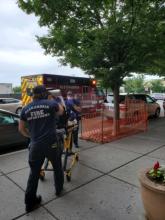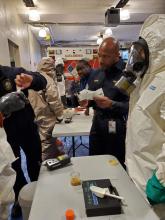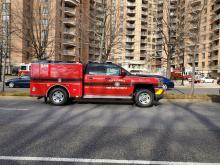AFD 2021 Organizational Restructure
AFD Organizational Restructure Overview
The Alexandria Fire Department (AFD) will implement an organizational restructure, effective Saturday, June 12, 2021. The goals of the changes are to
improve service efficiency and response times across the City; reduce cost; increase safety on the roadways; and improve response preparedness for specialty teams such as the Technical Rescue, Hazardous Materials, and Inland Water Rescue teams.
For your convenience, AFD is providing the following flyer explaining the upcoming organizational restructure:
- 2021 AFD Restructure Flyer (Amharic)
- 2021 AFD Restructure Flyer (Arabic)
- 2021 AFD Restructure Flyer (English)
- 2021 AFD Restructure Flyer (Spanish)
AFD hosted a series of community engagement sessions to discuss the organizational restructure. Access video of those sessions below:
- Saturday, June 5, 2021, at 10 a.m.
- Monday, June 7, 2021, at 2 p.m.
- Thursday, June 10, 2021, at 7 p.m.
View the news release about the organizational restructure. To arrange for a representative from the Alexandria Fire Department to present the upcoming improvements to your community organization, email AFD.PIO@alexandriava.gov.
Advanced Life Support (ALS) & EMS Lieutenants
Several fire apparatus will be minimally staffed with (1) ALS provider. Upgrading Engine 201 and Truck 208 to ALS units improves ALS coverage in Old Town

and in the Landmark area, to correspond with the higher call volume for medical service in those areas. The ALS suppression units are:
- Engine 201
- Engine 205
- Engine 206
- Engine 208
- Truck 208
EMS Lieutenants are promoted ALS officers. They will be allocated to units throughout the City on each shift to provide a higher quality of care.
- Station 206 – EMS Lieutenant Supervisor Vehicle designated as EMS 231
- Station 206 – EMS Lieutenant on M206
- Station 208 – EMS Lieutenant on M208
- Station 205 – EMS Lieutenant on M205
Specialty Teams
AFD's specialty teams will be restructured to improve response preparedness and resource integration. Currently, the swift water function of technical rescue

responds from Station 204 (900 Second St.) as a separate team. Traditionally, swift water rescue is a part of technical rescue teams, and this modality is included in the national professional standards for technical rescue specialty. In anticipation of continued growth in the City and to balance rescue squad coverage, the Technical Rescue Team will move to Station 209 (2800 Mainline Blvd.); Inland Water Rescue will also relocate to Station 209 for more efficient response to possible flooding in the City and to combine its response and training efforts with technical rescue.
The Hazardous Materials Team will move to Station 210 (5255 Eisenhower Ave.) for more efficient response to the industrial park, Norfolk Southern Ethanol Transloading Facility and easy access to the interstate, where nationally most hazardous material emergencies occur.
Battalion Management Teams (BMTs)

AFD will create BMTs comprised of a Battalion Chief and an EMS/Fire Captain for all three shifts on both the East and West Battalions. BMTs work together as one functioning unit to improve our all-hazards approach and increase safety while responding on the roadways.
- BMT 211 (East End) – Battalion Chief 211 and an EMS Captain
- BMT 212 (West End) – Battalion Chief 212 and a Fire Captain
National Fire Protection Association (NFPA) Standards
NFPA 1006
NFPA 1006 – Standard for Technical Rescue Personnel Professional Qualifications
NFPA 1670
NFPA 1670 – Standard on Operations and Training Technical Search and Rescue Incidents
NFPA 1710
NFPA 1710 – Standard for the Organization and Deployment of Fire Suppression Operations, Emergency Medical Operations, and Special Operations to the Public by Career Fire Departments
NFPA 1855
NFPA 1855 – Standard on Selection, Care, and Maintenance of Protective Ensembles for Technical Rescue Incidents
NFPA 1951
NFPA 1951 – Standard on Protective Ensembles for Technical Rescue Incidents